- getting started
Introduction: Cloud
Introduction: Community
Testsigma Community Cloud
FAQs
Telemetry
Testsigma Terminology
Testsigma Sample Applications
- collaboration
Invite Team Members
Users & Role Management
Assign Projects
Review Management [Test Cases]
Review Management [Elements]
Delete Users from Project
Control Who Can Stop Execution via Usage Details and Run Results
- test cases
Manage Test Cases
Test Case Details, Activity & History
Test case list actions
Test case filters
Import and Export Test Cases
Import Test Cases from YAML/GIT
Import Postman's Collections and Environments
Test cases for Desktop Windows
Update Test Case result in a Test Plan
Test cases for Mobile Web Application
- Test Step Types
Create Test Steps in Testsigma
Type: Natural Language
Type: REST API
Type: Step Group
Type: For Loop
Type: While Loop
Type: Block
Type: If Condition
Nested Step Groups
Create Test Steps
- Create Test Steps Using Simple English
Test Step Settings
Test Step Actions
Test data in steps
Reuse Elements
Test Step Reordering
Bulk Actions
Add Steps Before & After
- Web Applications
Test Step Actions
Test Step Settings
Test Data in Steps
Add Steps Manually
Reuse Elements
Update Elements
Create an Element
Reorder Test Steps
Bulk Actions
Add Steps Before & After
Record steps anywhere in a Test Case
RESTful API Testing - Overview
API Request
Parameters
Body Data
Headers
Authorization
Verifications
Store Variables
Attachments
Stored Objects
Image Injection
Cross-application testing
- Test Data Management
- Test Data Types
Raw
Parameter
Runtime
Random
Data Generator
Phone Number
Mail Box
Environment
Concat Test Data
Create Test Data [Parameter]
Update test data profile
How to add value to test data profile using NLP
Import Test Data [Parameter]
Bulk Deletion of a Test Data Profile
Create Test Data [Environment]
- Elements(Objects)
- Web Applications
Record Multiple Elements[Recorder]
Capture Single Element[Recorder]
Create Elements [Manually]
Supported Locator Types
Different Strategies for Formulating Elements
Shadow DOM Elements
Verifying elements in Chrome DevTools
How to Handle iframe Elements?
- android apps
Record Multiple Elements[Recorder]
Capture Single Element[Recorder]
Create Elements [Manually]
Supported Locator Types
Different Strategies for Formulating Elements
- ios apps
Record Multiple Elements[Recorder]
Capture Single Element[Recorder]
Create Elements [Manually]
Supported Locator Types
Different Strategies for Formulating Elements
Using Parameter Test Data for Dynamic locators
Using Runtime Test Data for Dynamic locators
Using Environment Test Data for Dynamic locators
Import/Export Elements
- test plans
Add, Edit, Delete Test Machines
Add, Edit, Delete Test Suites
Schedule Test Plans
Run Test Suites In Parallel
Cross Browser Testing
Distributed testing
Headless Testing
Test Lab Types
Disable Test cases in Test plans
After Test in Test Cases and Step Groups
Post Plan Hook
AfterTest Suite
Email Configuration in Test Plan
Execute Partial Test Plan Run via API
Ad-hoc Run
Test plan executions
Dry Runs on Local Devices
Run Tests on Vendor Platforms
Run Test Plans on Local Devices
Test Locally Hosted Applications
Debug Test Case Failures
Parallel and Allowed queues
- debugging
Debug results on local devices (Web applications)
Debug Results on Local Devices
Launch Debugger in the Same Window
- Testsigma Agent
Pre-requisites
Setup: Windows, Mac, Linux
Setup: Android Local Devices
Setting up iOS Local Devices
Update Agent Manually
Update Drivers Manually
Delete Corrupted Agent
FAQs
- continuous integration
Test Plan Details
REST API(Generic)
Jenkins
Azure DevOps
AWS DevOps
AWS Lambda
Circle CI
Bamboo CI
Travis CI
CodeShip CI
Shell Script(Generic)
Bitrise CI
GitHub CICD
Bitbucket CICD
GitLab CI/CD
Dashboard
- visual testing
Visual Testing
View & Debug Results
Update Baseline
Visual Testing - Configure Test Cases
- desired capabilities
Most Common Desired Capabilities List
Enable Browser Console Debugging logs
Geo location for Localization(L10N)
Avoid unsafe download prompt(Chrome)
Set geo location(latitude, longitude) Chrome & Firefox
Custom User Profile - Chrome
Emulate Mobile devices with Chrome Browser
Add Chrome Extension
Network Throttling
Network Logs
Biometric Authentication
Enable app resigning in iOS
Enable capturing screenshots for Android and iOS
Configure Android WebViews
Run Browser in Incognito/Private mode
- addons
What is an Addon?
Addons Community Marketplace
Install Community Addon
Prerequisites(Create/Update Addon)
Create an Addon
Update Addon
Addon Types
Create a Post Plan Hook add-on in Testsigma
How to create OCR Text Extraction Addon
- configuration
API Keys
- Security(SSO)
Setting up Google Single Sign-On(SSO) login in Testsigma
Setting Up Okta Single Sign-On Integration with SAML Login in Testsigma
Setting up SAML-based SSO login for Testsigma in Azure
iOS Settings
Reset Password (Community)
Storage Types (Community)
- uploads
Upload Files
Upload Android and iOS Apps
How to generate mobile builds for Android/iOS applications?
- Testsigma REST APIs
Environments
Elements
Test Plans
Upload Files
Get Project wide information
Upload and update test data profile
Trigger Multiple Test Plans
Trigger Test Plan remotely and wait until Completion
Run the same Test Plan multiple times in Parallel
Schedule, Update and Delete a test plan using API
Update Test Case results using API
Create and update values of Test Data Profile using REST API
Rerun Test Cases from Run Results using API
- open source dev environment setup
macOS and IntelliJ Community Edition
macOS and IntelliJ Ultimate Edition
Windows and IntelliJ Ultimate Edition
Setup Dev Environment [Addons]
- NLPs
Unable to retrieve value stored in text element
Unable to capture dropdown element
Unable to Select Radiobutton
Unable to Click Checkbox
Why mobile device not displayed in Testsigma Mobile Test Recorder?
Unable to create new test session due to unexpected error
Test step type: Step groups
Sometimes, a group of steps is common to multiple test cases.
For example:
- You cannot perform a fund transfer without adding an account first.
- You cannot delete a beneficiary account without adding an account first.
- Loan disbursement requires adding an account first
Here adding an account is a common step.
Traditionally, instead of writing the same redundant code over and over again, test engineers solve this problem by using modular coding, or adding all these repeating steps to a function and calling that function every time it’s needed. In Testsigma, you can do the same using step groups.
A Step group is a group of test steps which can be repeatedly used in multiple test cases. So, instead of using the same steps over and over again, we simply create a test step group and invoke the step group when required.
Create a new step group
- Navigate to Test Development > Test Cases > Step Groups.
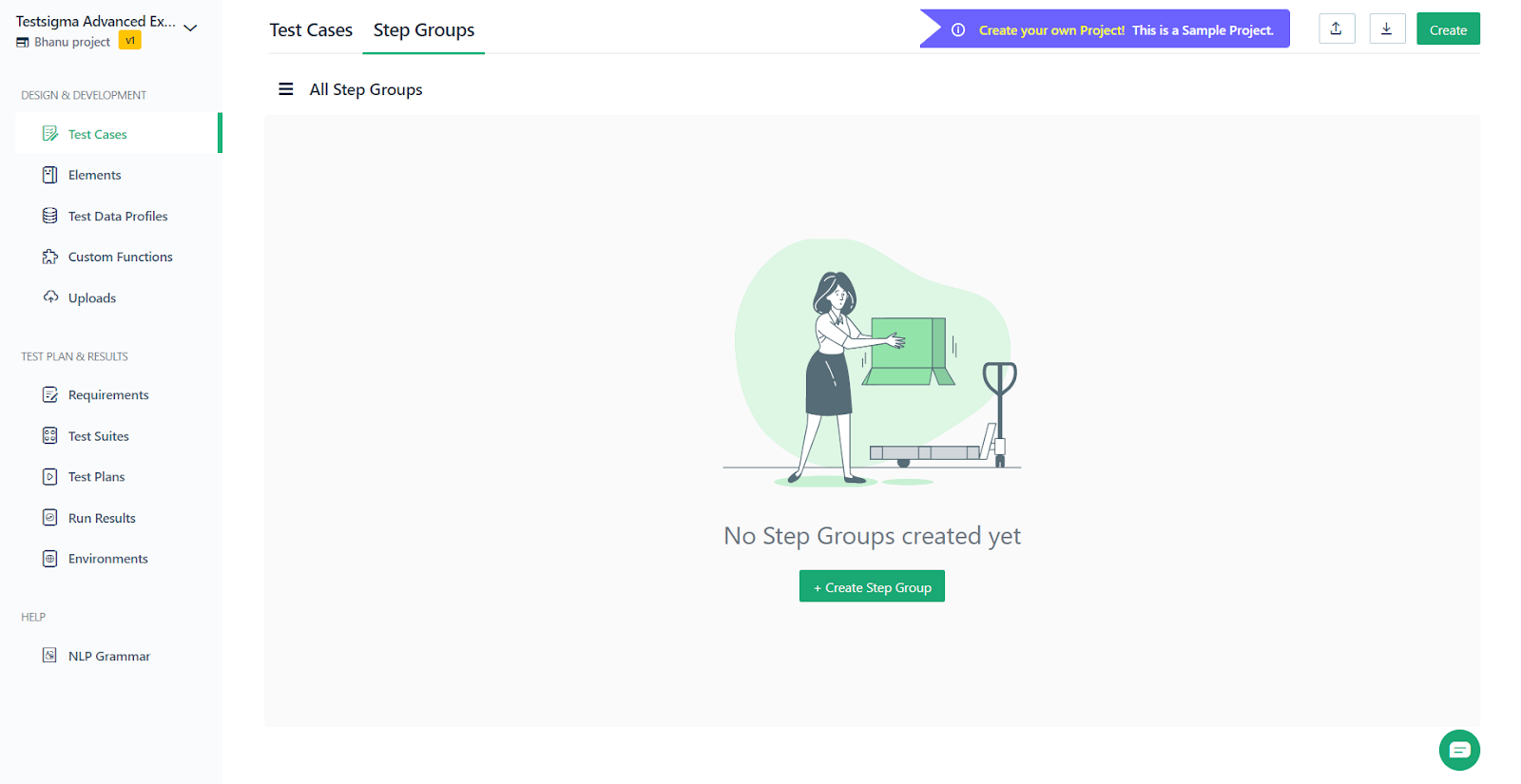
- Click + Create Step Group.

- Enter a name, description and choose options in the Advanced options menu and finally click the Create button.
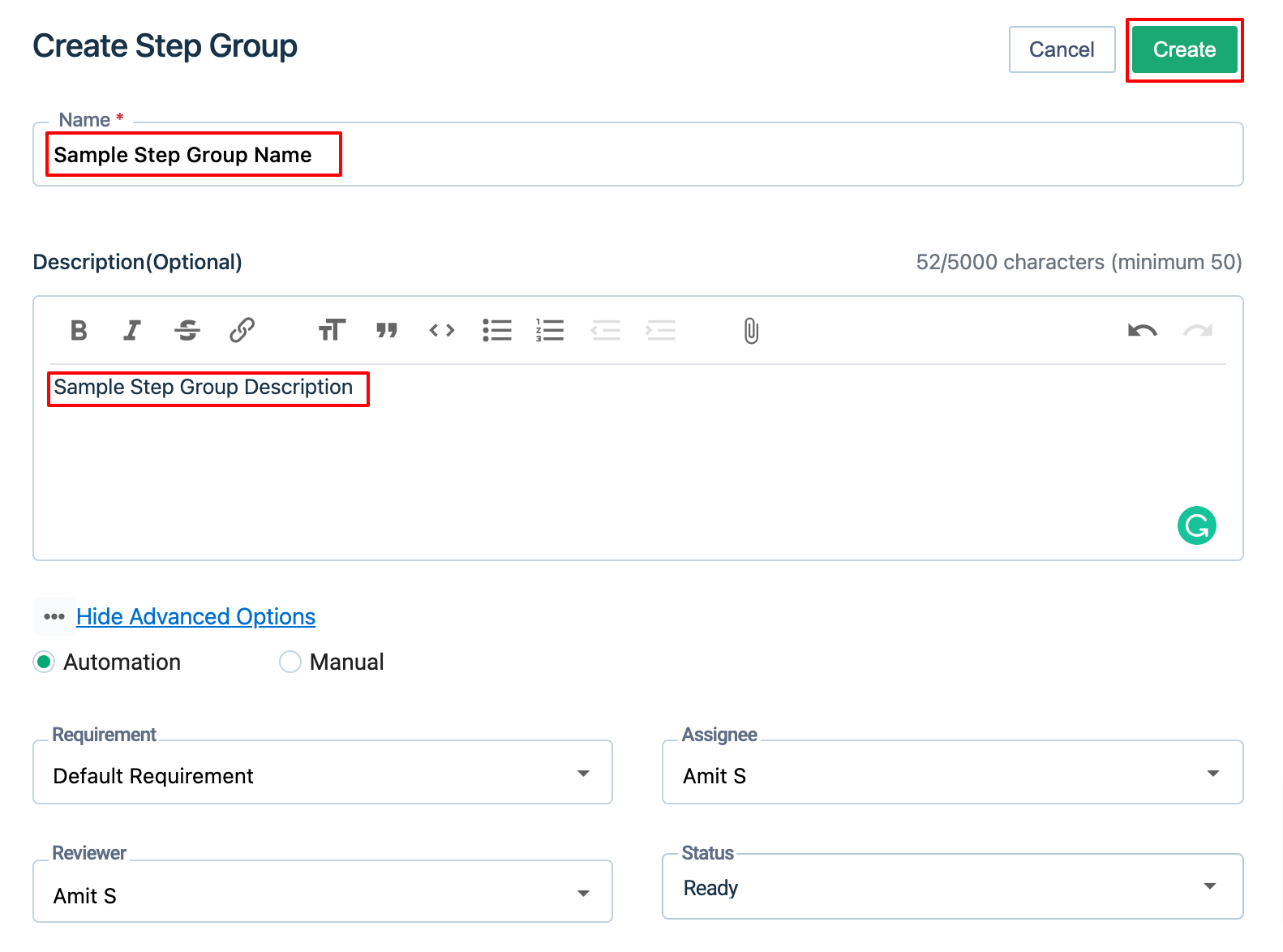
- This will create a step group with no steps
- Add test steps required to this step group. A sample screenshot is attached below for your reference:
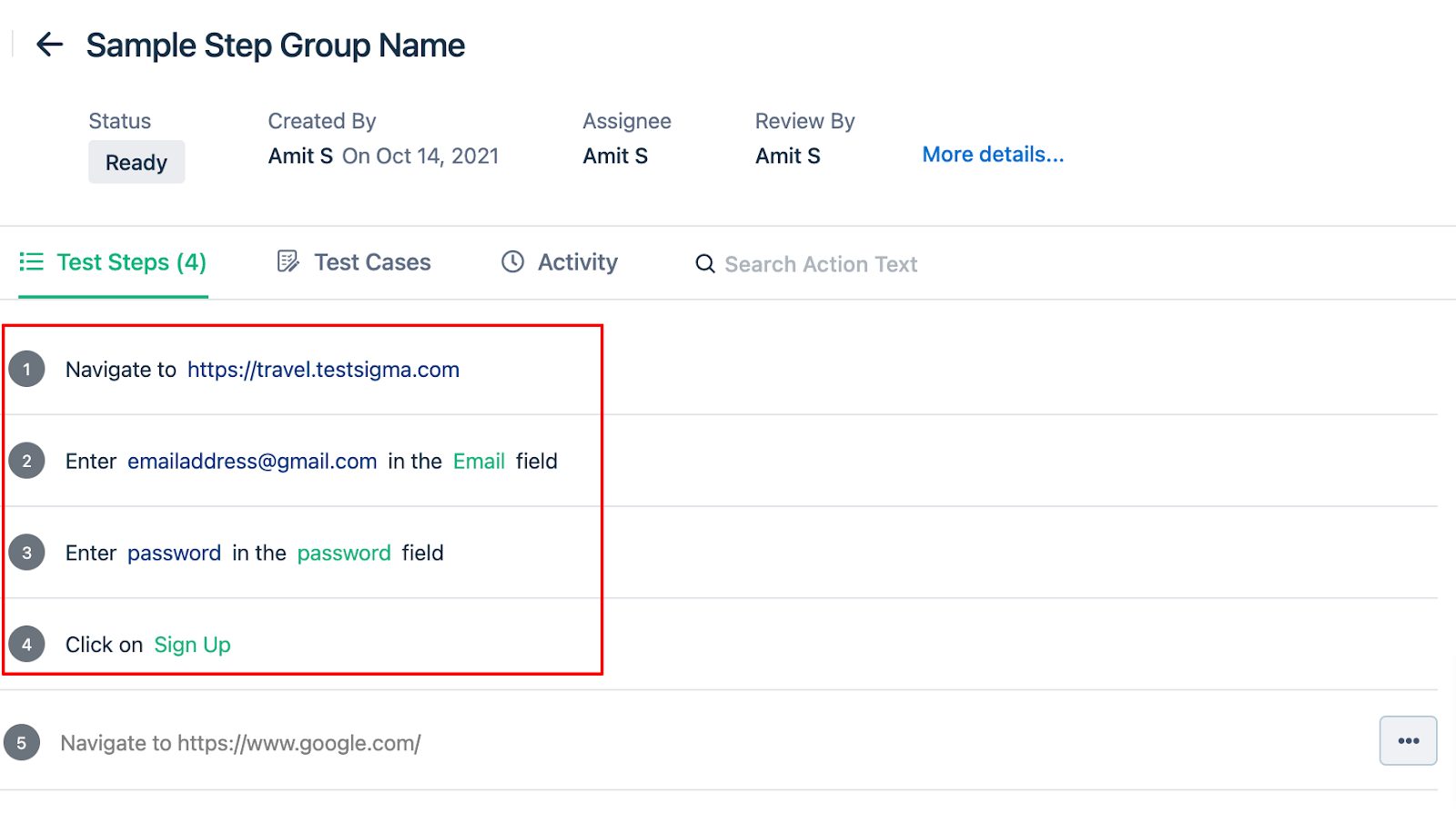
- And now you will have a step group ready to use.
Edit a step group
To edit a step group, universally, for all related test cases:
- Navigate to Test Development > Test Cases > Step Groups.
- Click on the step group you want to edit.
- Now you can make the changes you want to the step group. The changes will be reflected in all the test cases that use the step group.
The number of test cases impacted by the changes in a step group will be visible on the step group page, for example, in the screenshot below, any change in the step group will impact 4 test cases:

To edit a step group for a specific test case:
- Navigate to Test Development > Test Cases.
- Click on the specific test case for which you want to edit the step group.
- Inside the test case, go to the step group you want to edit.
- You can spot edit any test data or element being used in the step group. After editing click outside the step to save the changes.
- To spot edit test data:
Click on the test data to see the type of test data that can be added to the step.Select the type of test data you want to add and proceed.
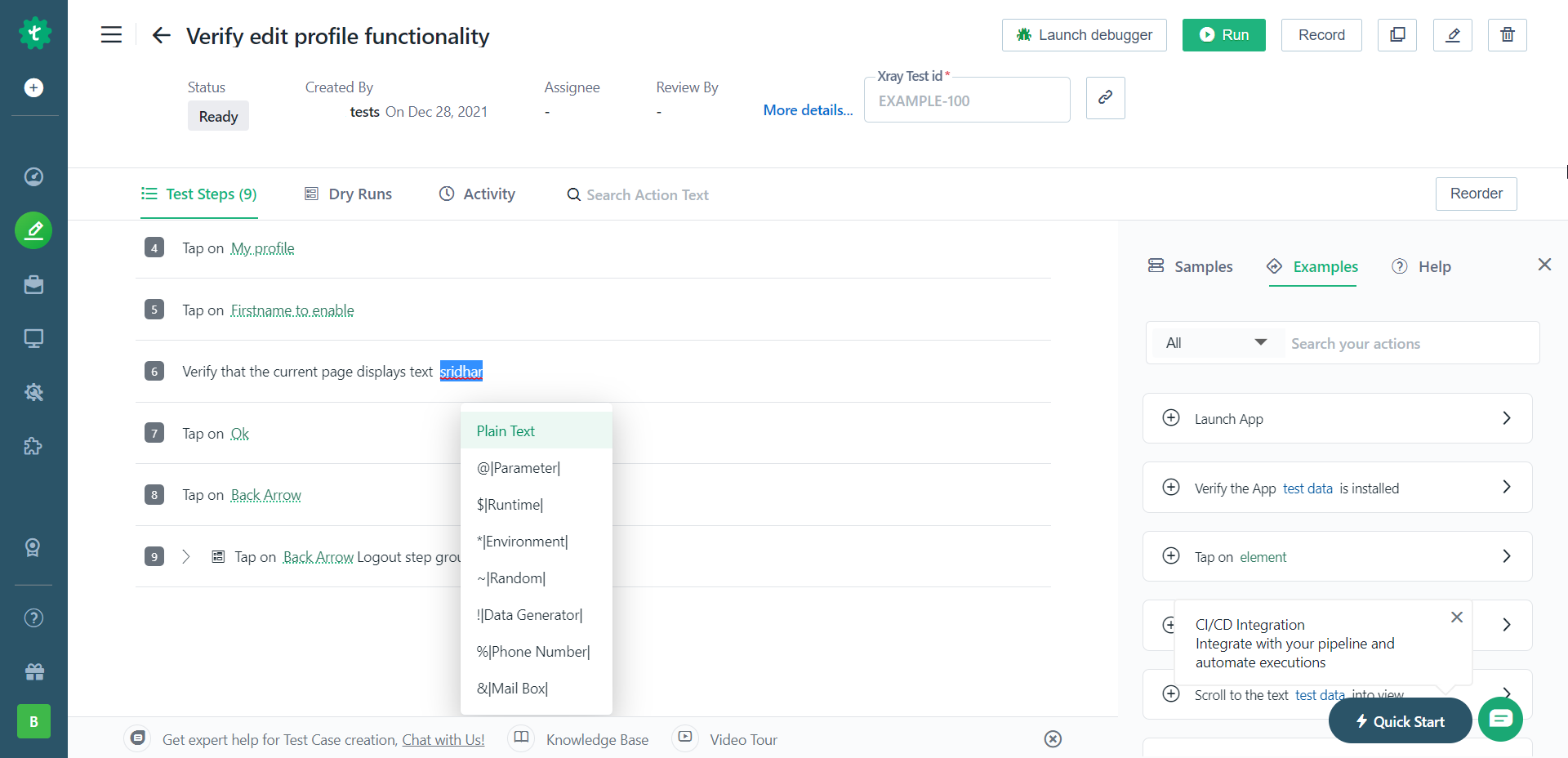
- To spot edit element:
Click on the element the required field should become editable.You can either create a new element or edit the existing element.
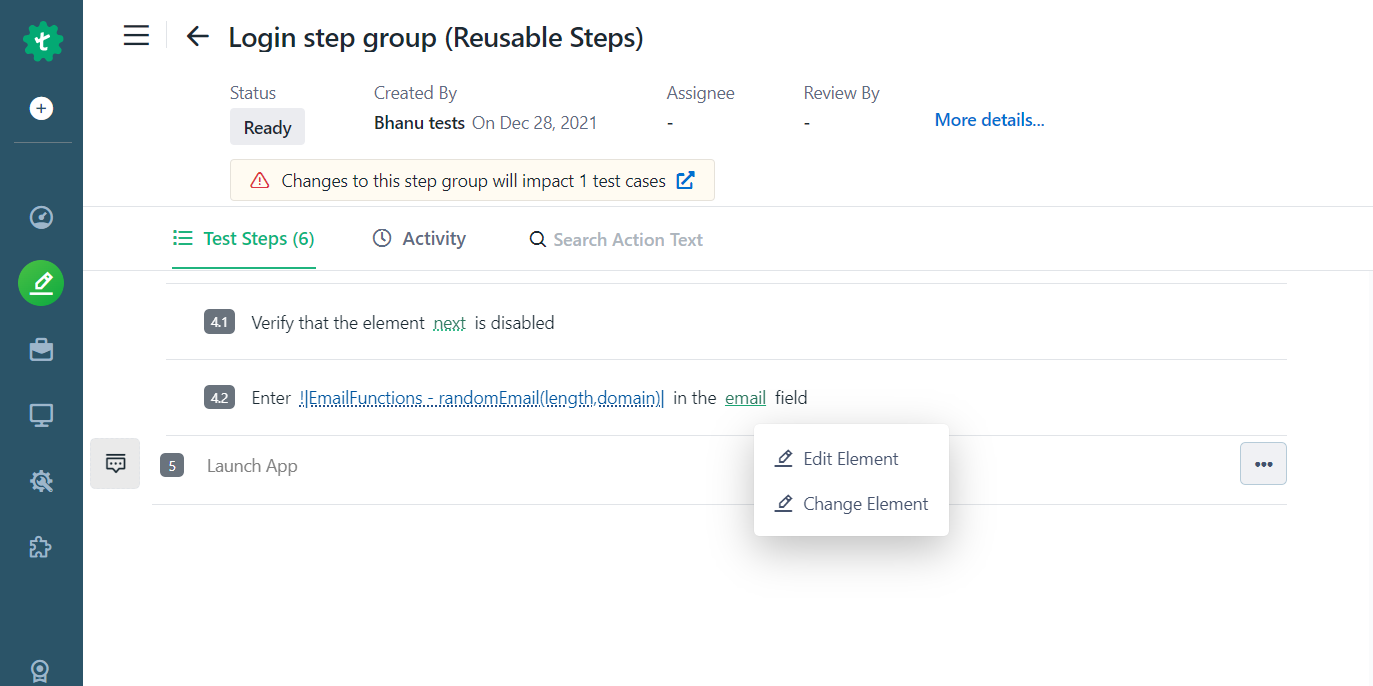
Alternatively, you can edit the element name inline,refer the attached GIF to see the changes:
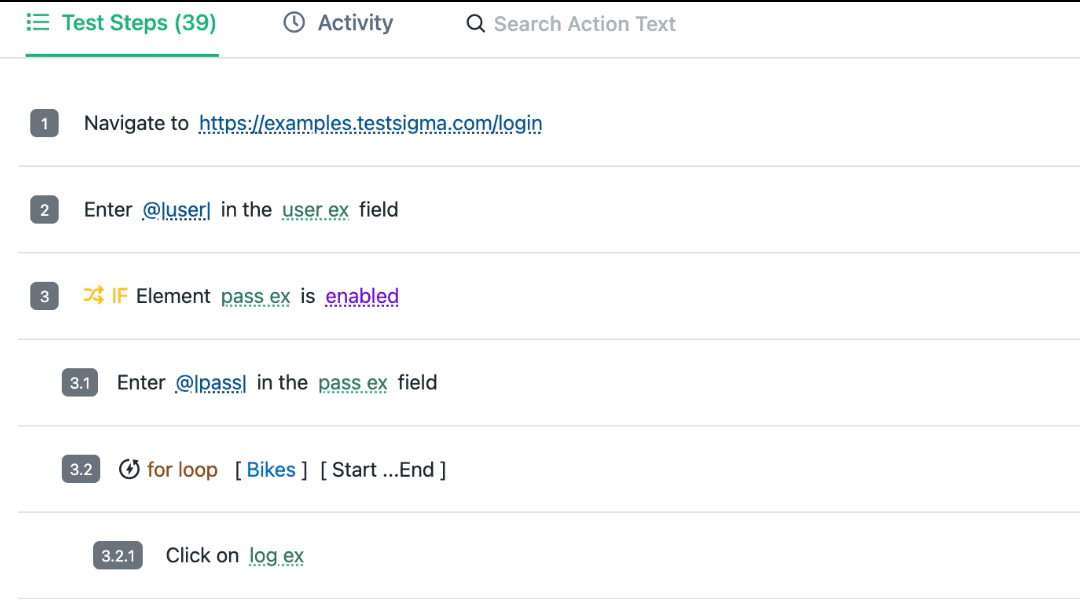
To edit the test data profile associated with a for loop in a step group
- Navigate to Test Development > Test Cases.
- Click on the specific test case for which you want to edit the step group.
- Inside the test case, go to the step group you want to edit.
- Inside the step group, go to the for loop for which you want to edit the associated test data profile.
- Click on the Edit button corresponding to the for loop and change the associated test data profile. For example, as also can be seen in the below GIF:

Create a step group from a test case
- Navigate to a test case.
- Select the steps that you want to create a step group from.
- Once you start selecting the test steps, the + Create Step Group will appear at the top right of the test steps, as also shown in the screenshot below:
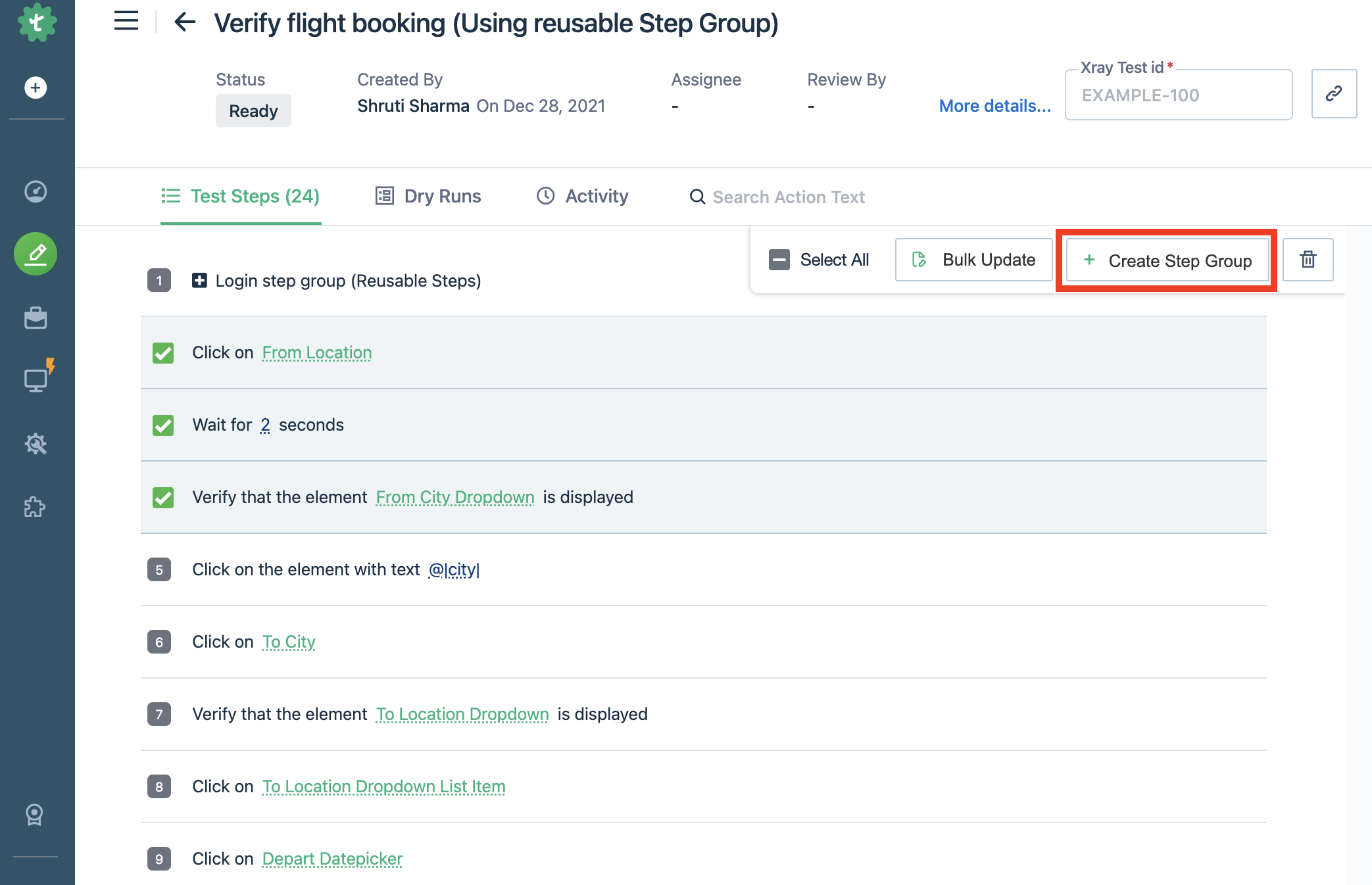
- If you select consecutive test steps then you will see a pop-up as below:
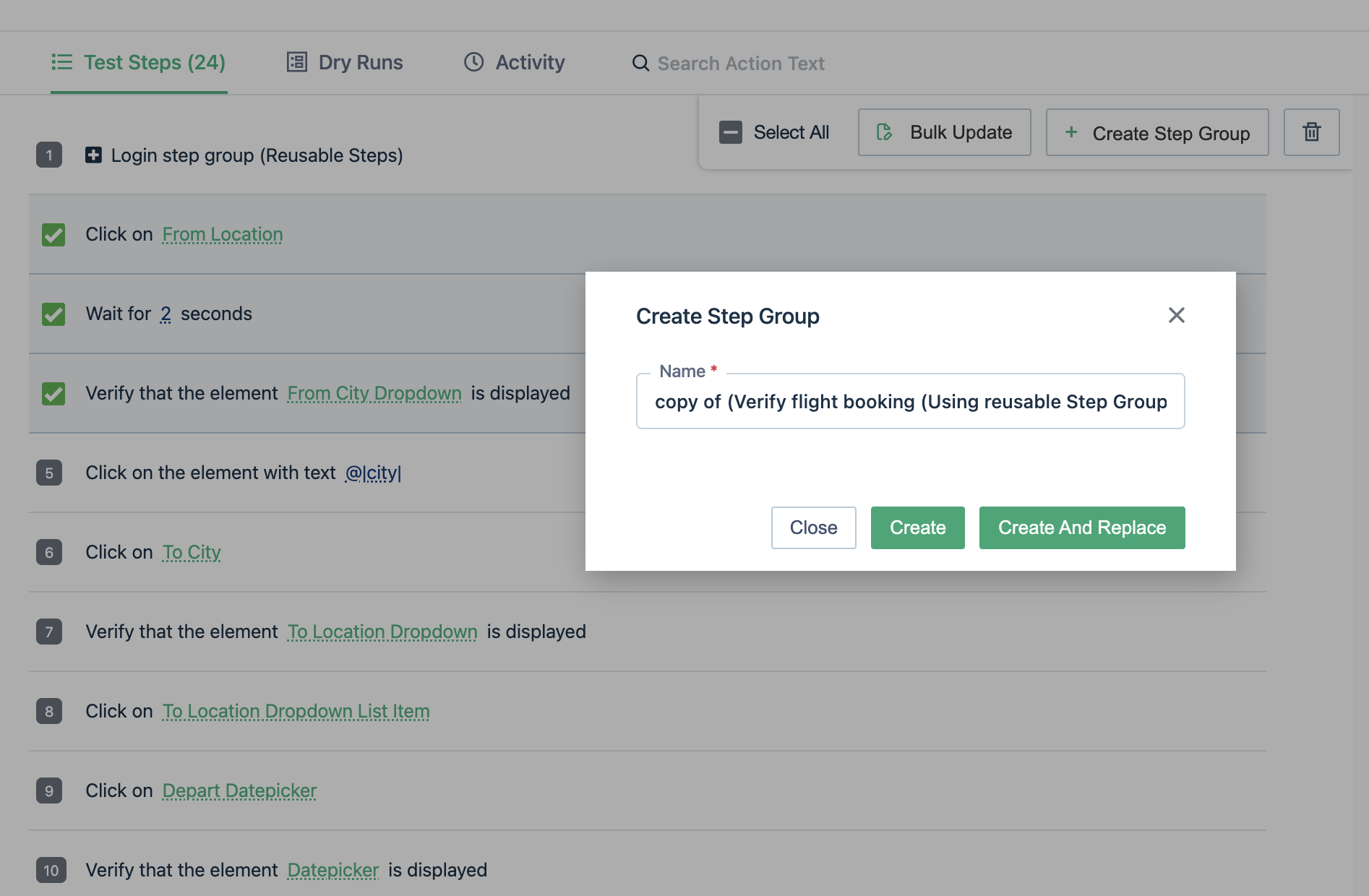
while if you don't select consecutive test steps then the pop-up that appears won't show you the Create and Replace button as shown below.
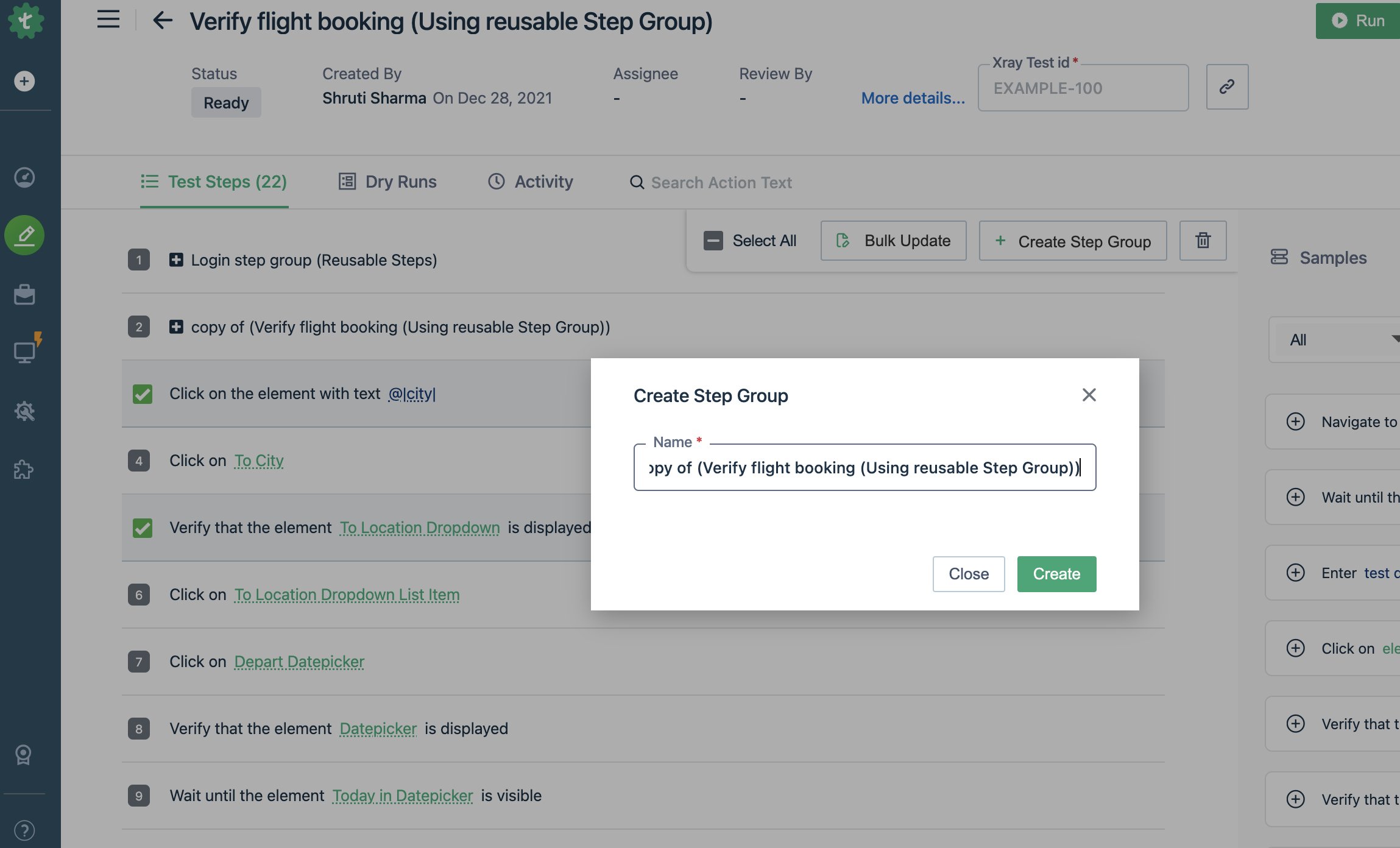
- If you click on the Create button, a new step group with the selected test steps and the given name would be created.
- If you click on the Create and Replace button, a new step group with the selected test steps and the given name would be created and the selected test steps would be replaced by the created step group.
Below is a GIF demonstrating how the create and replace step-group functionality works:
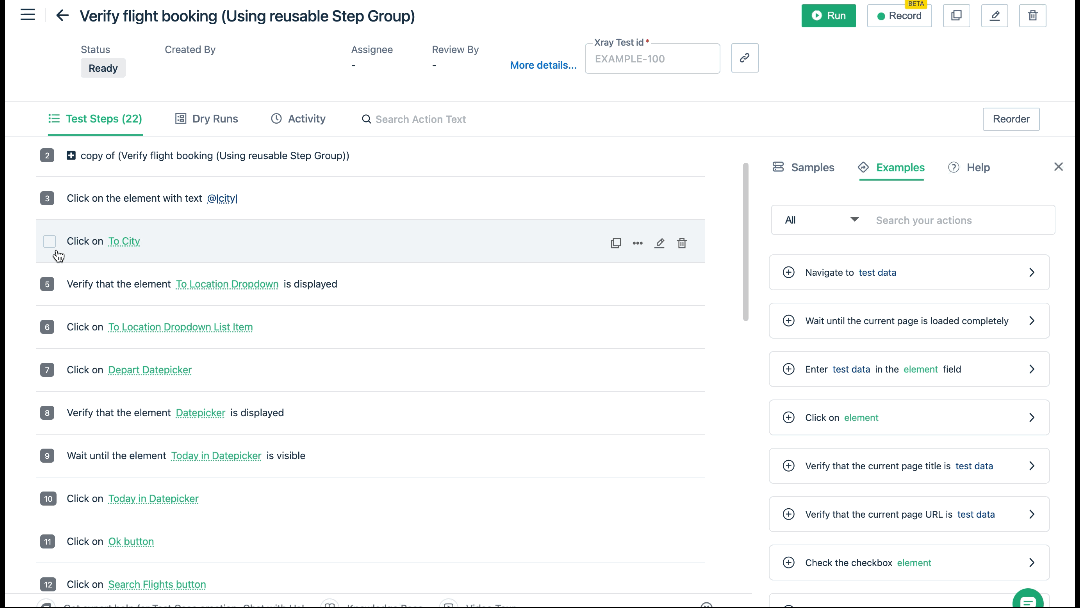
Use step group in a test case
- Click on test case and open the test case that you need to author as shown in the screenshot below:
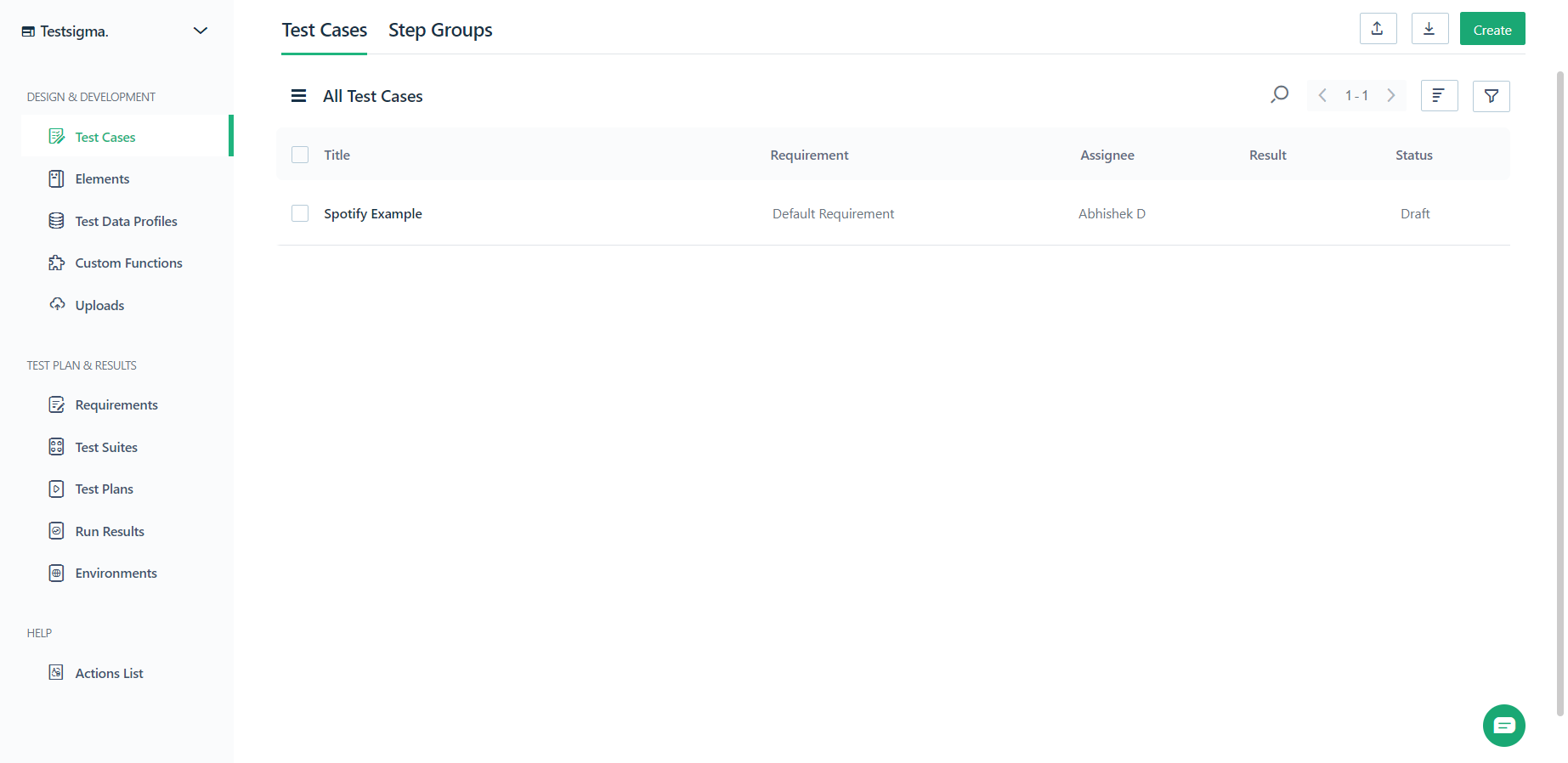
- Clicking on the specific test case will open the test case details page

- From the left side dropdown, select Step group.
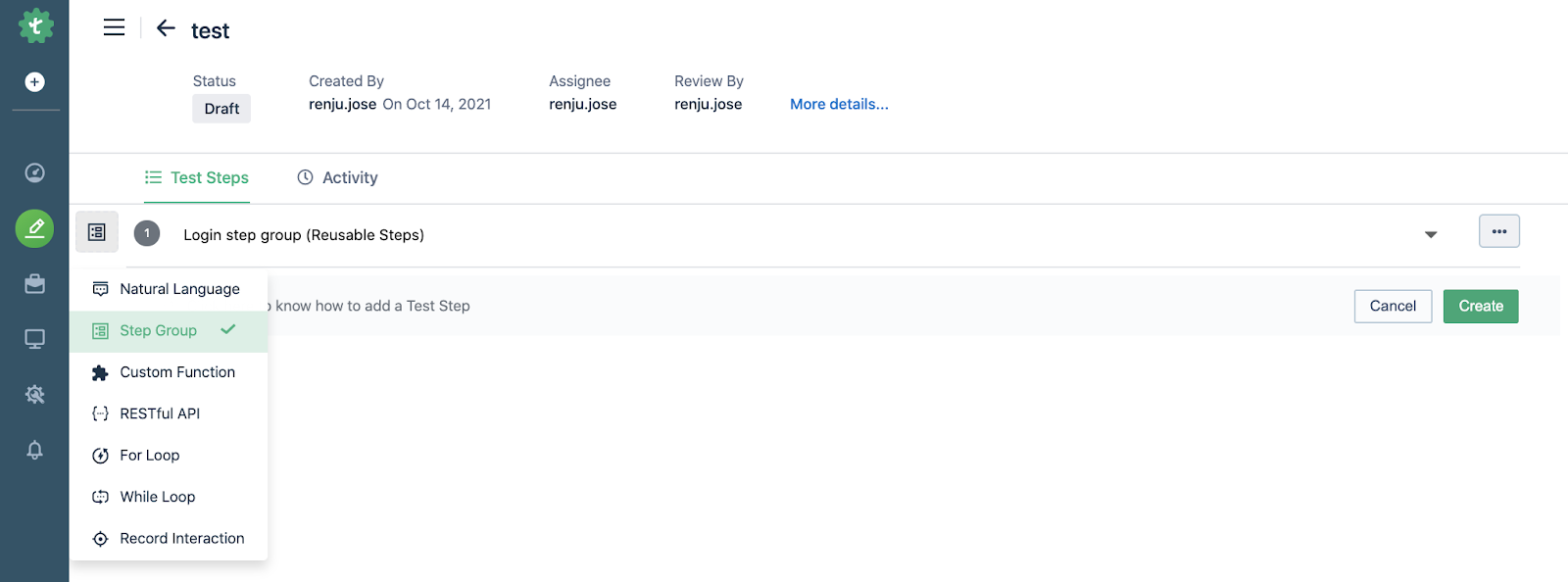
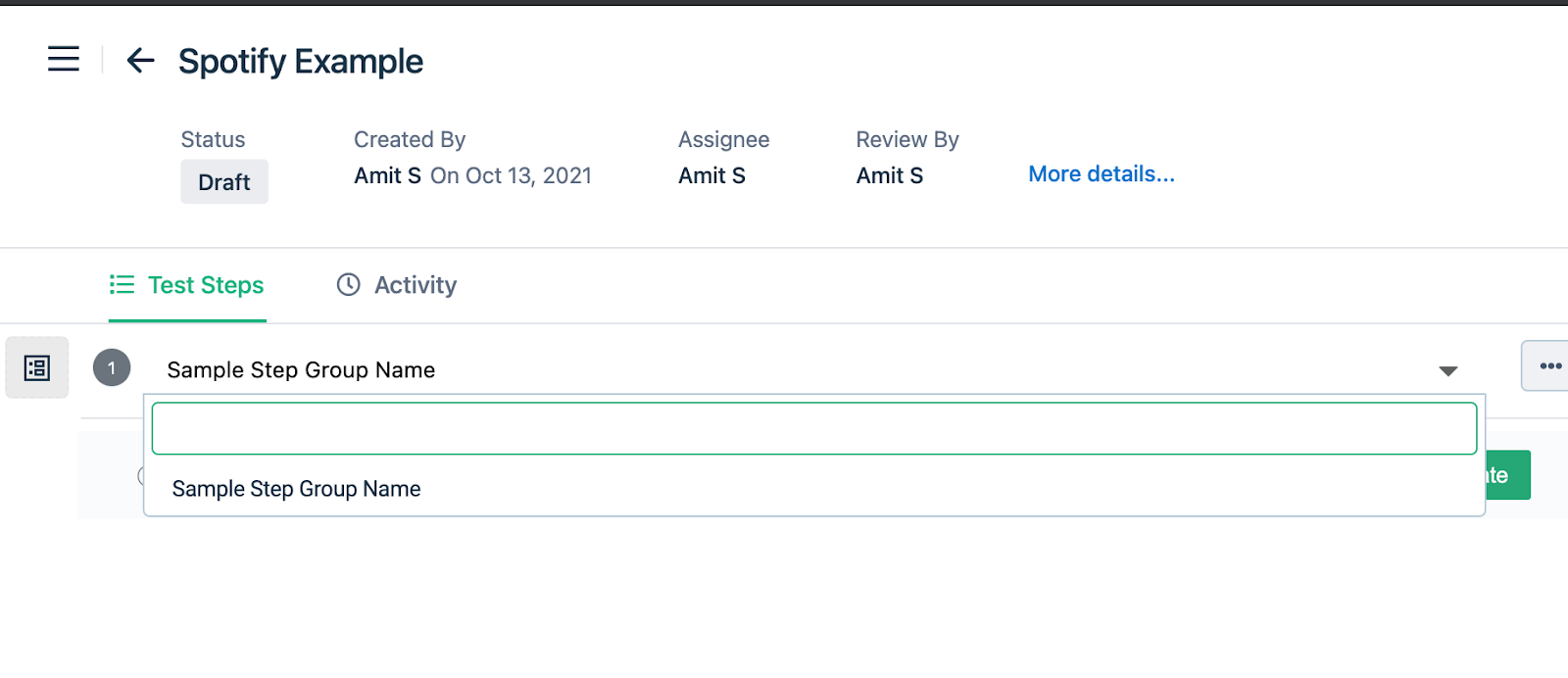
- From the list of step groups, select the step group you need. In this case, we have only created one step group and hence only one is visible in the drop-down.
- Once you have selected the step group, the step group description and link would be visible too. As shown in the screenshot below:
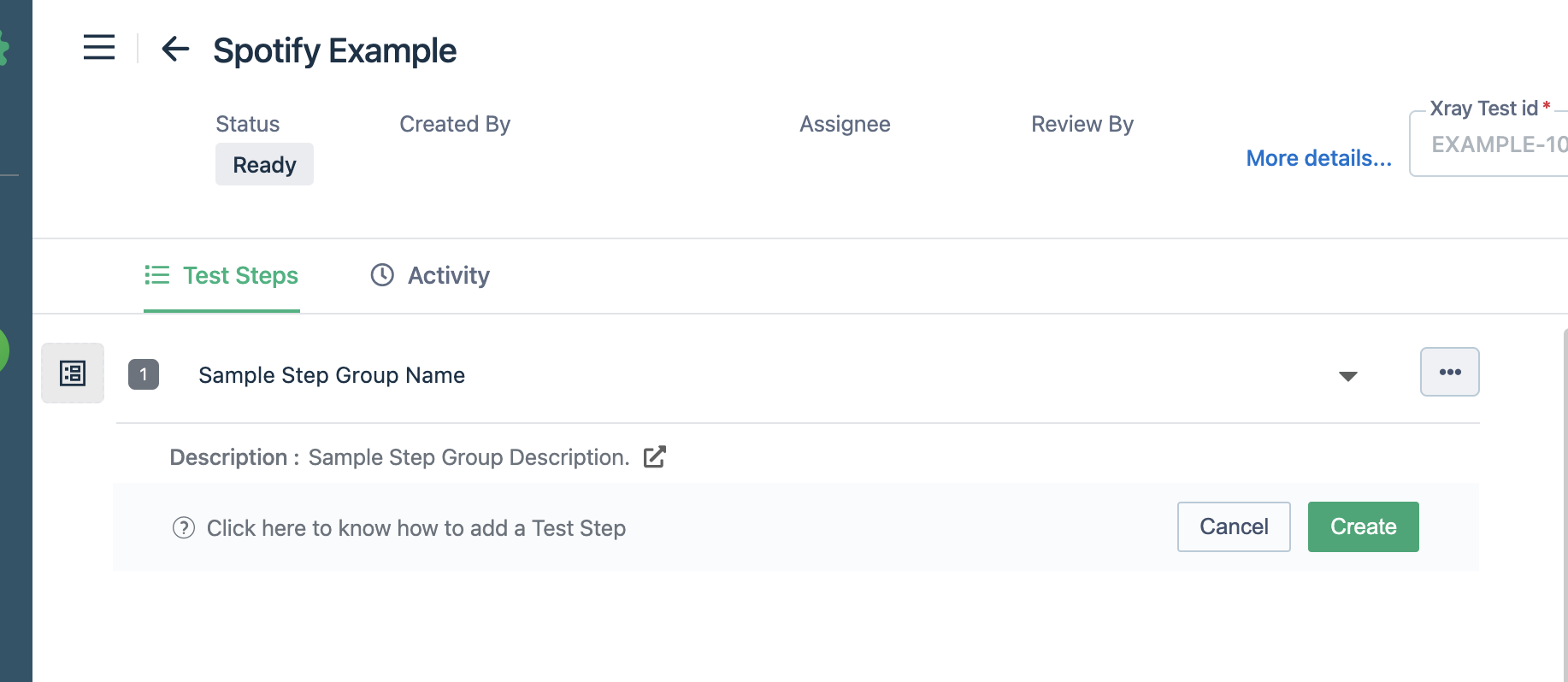
Now you are ready to use the step group in your test case
Observe the GIF below to understand how to create a step group.
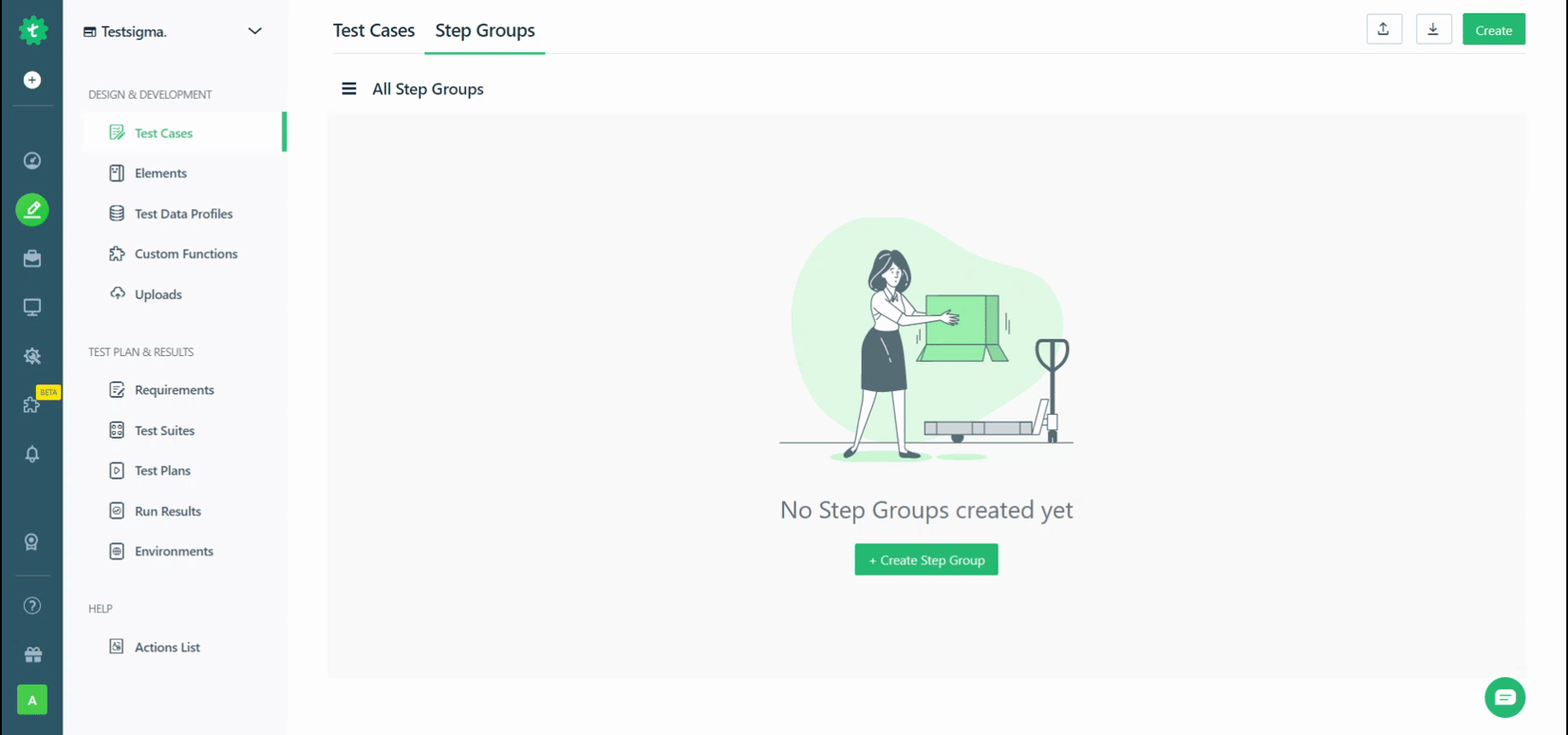
Deleting a Step Group will also be deleted the associated Test Cases.
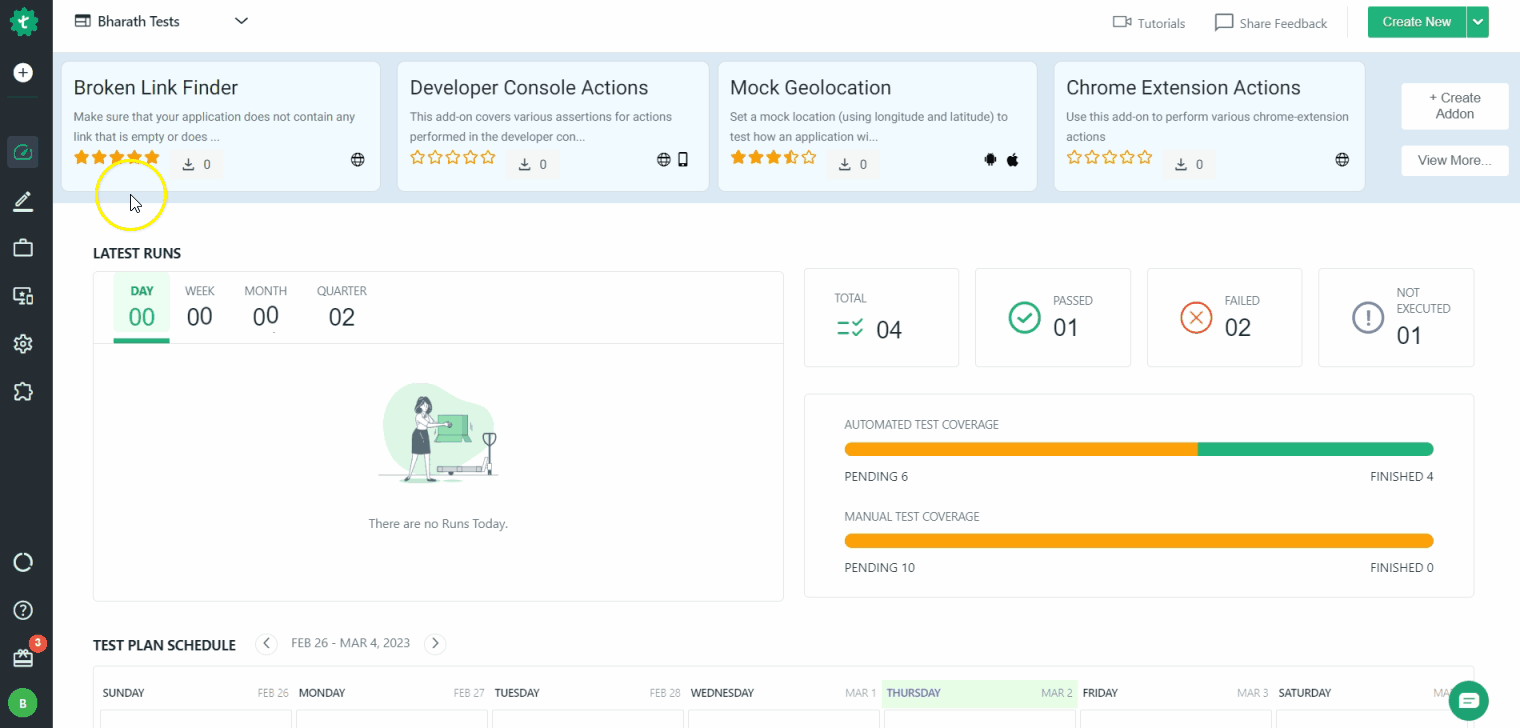
Create a data-driven step group
Just like data-driven test cases, you can create data-driven step groups which can be utilized like standard components across test cases
- When creating a step group, select the Data-driven toggle button, specify the test data profile you want to use, and the iterations you intend to use in this step group.
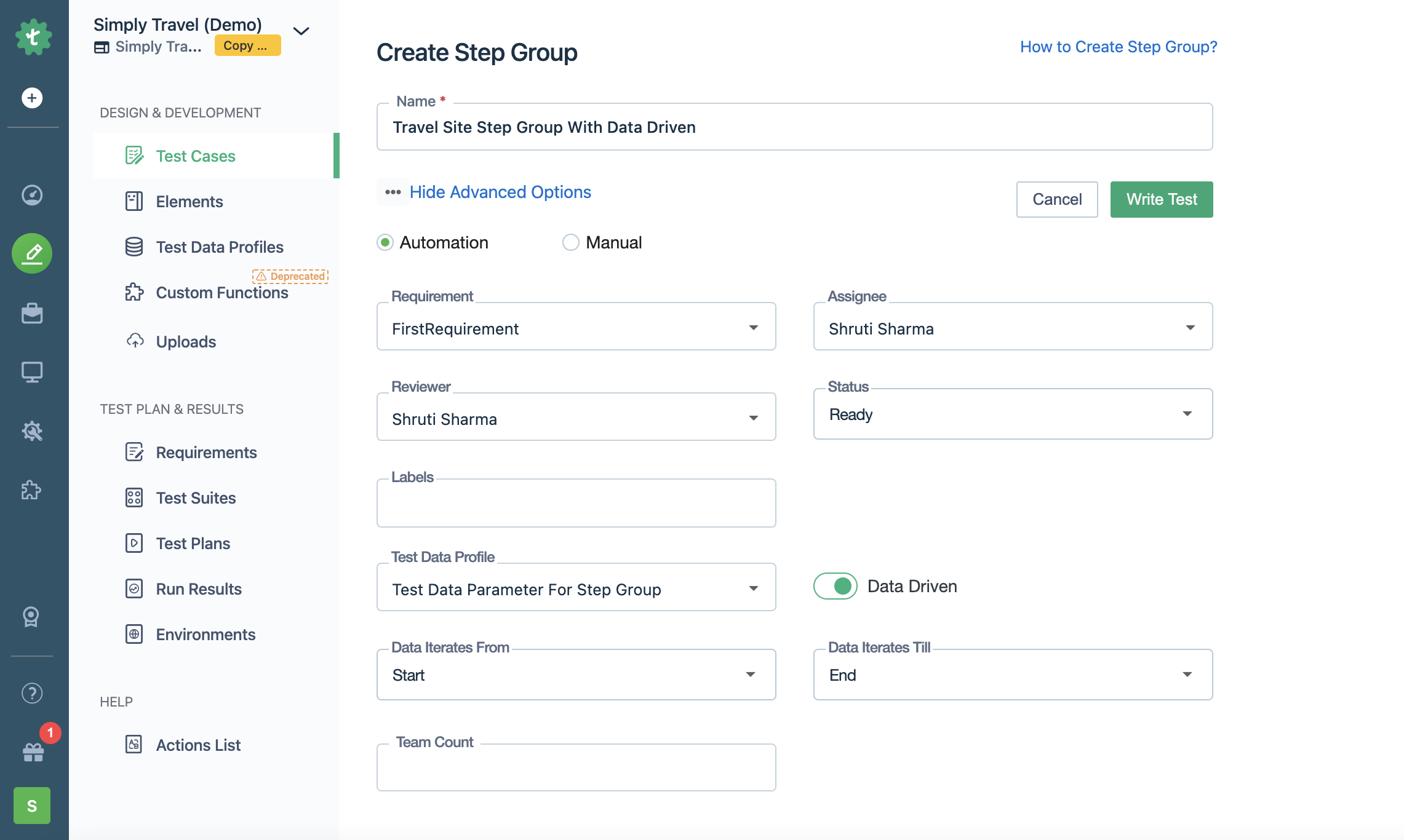
- Now add the NLP steps where you want to iterate through the test data profiles in the test case just like you would for a data-driven test case.
In our example below, we are iterating over multiple mobile phone numbers and emails
Your data-driven step group is ready for use across multiple test cases.
Using a data-driven step group in test case
You can create a vanilla test case or a data-driven test case on test sigma and add the data-driven step group to the test case like in the example below.
Adding data-driven step groups to a data-driven test case allows iterating through multiple data sets via the step group for every single iteration of your data-driven test case.
Adding step groups to the test case can be done using step type dropdown.

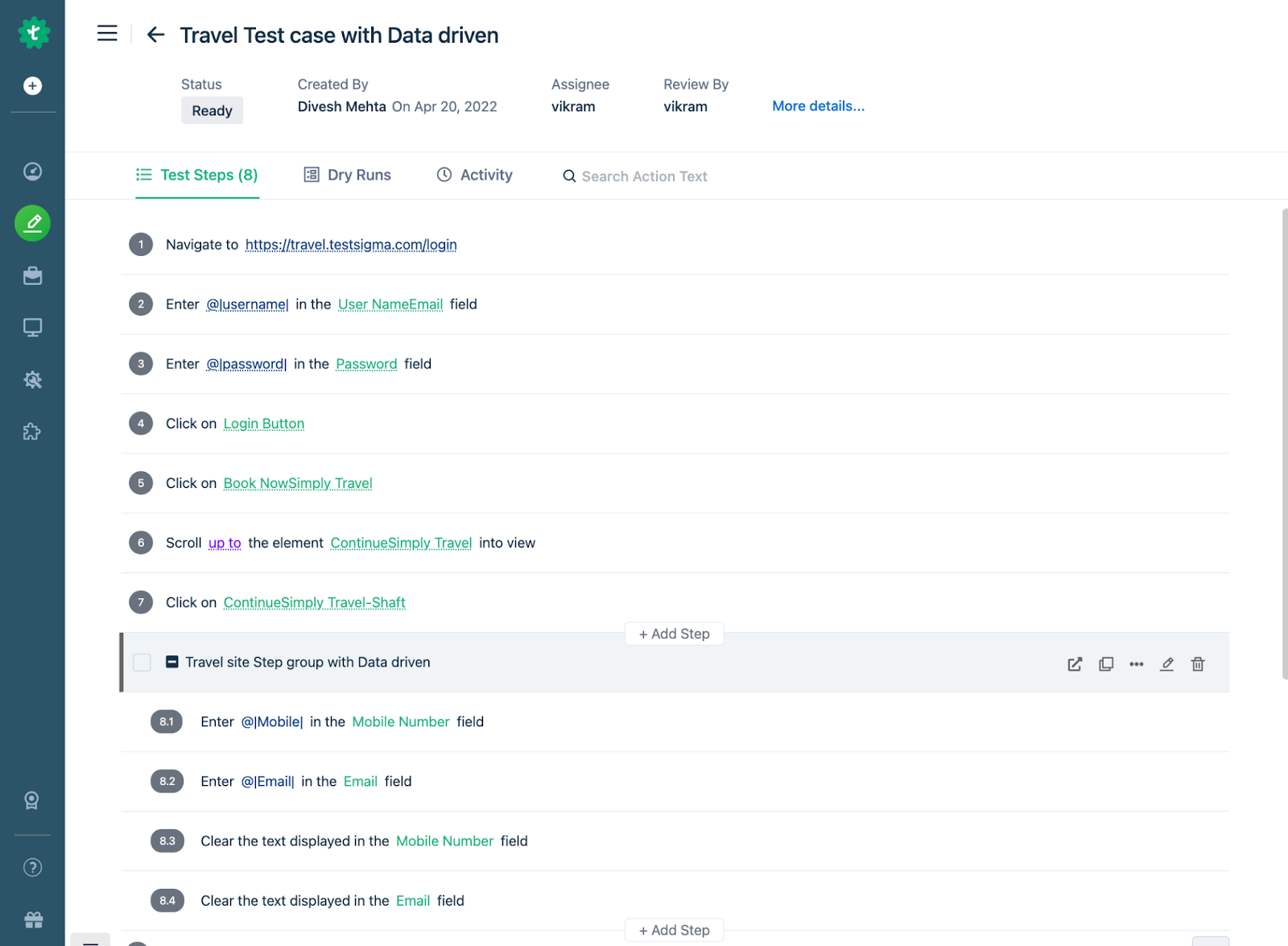
Control over step group iterations in test case
There may be situations where out of the 100 sets in the test data profile attached to your step group, you want to iterate from set 5 to set 10 in your data-driven step group only and not all of them.
You can use the following restricted Runtime variables to specify which sets in from the step group data profiles you want to iterate through.
RunTime TestDataSet Start
RunTime TestDataSet End
- When creating a data-driven step group ensure you select the option Overwrite Test Data Set with Runtime Variable like in the image below:
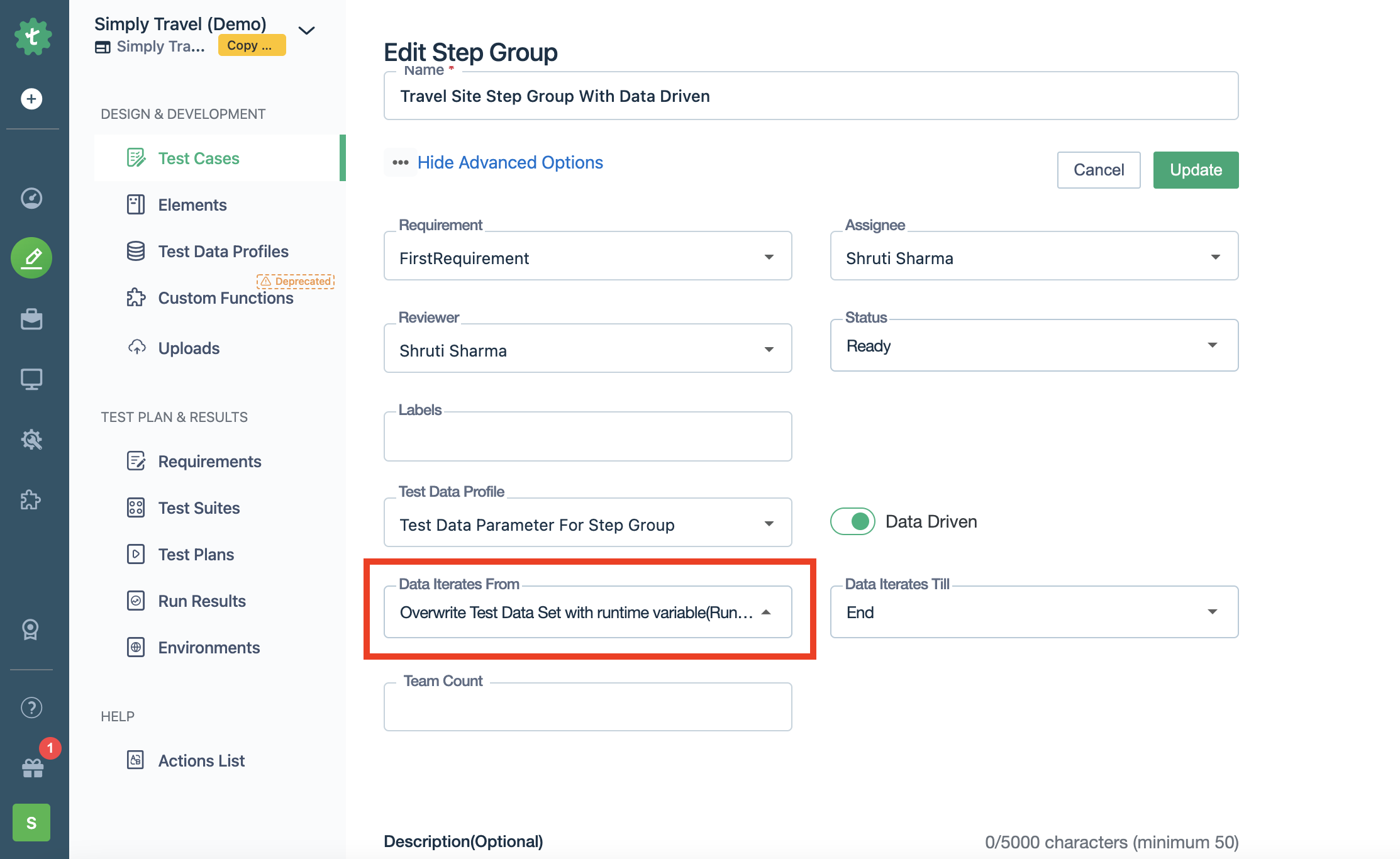
- Use the store NLP instructions to assign set names to the RunTimeTestDataSetStart = Set Name to START iteration from [Case Sensitive]_
Use the store NLP instructions to assign set names to the RunTimeTestDataSetEnd = Set Name to END iteration from [Case Sensitive]_
- We will automatically use the value set in these variables when we reach the step group to identify start and end iteration set names.

Access test data profile, from parent step, within a data-driven step group:
When you create a data-driven step group, you may want to use the step group within loops for example a for loop. With Testsigma, you can access the test data profile that was passed in the parent test step.
To understand this better, let us have an example test case where we are testing if a user can login successfully for the given usernames and passwords. The usernames and passwords are being passed via associated test data profiles.
Prerequisites:
- A data-driven step-group. For more information, refer to create a data driven step group.
- A data-driven test case. For more information, refer to create a data driven test case.
- You should be familiar with for loops and test data profiles in Testsigma. For more information refer to for-loops and test data profiles.
Steps
- Create multiple test data profiles that will have different sets of usernames and passwords.
- Create a data-driven step group that would login to a website using the usernames and passwords passed via the associated test data profile. For our test case we have created a data-driven step group that looks like below:
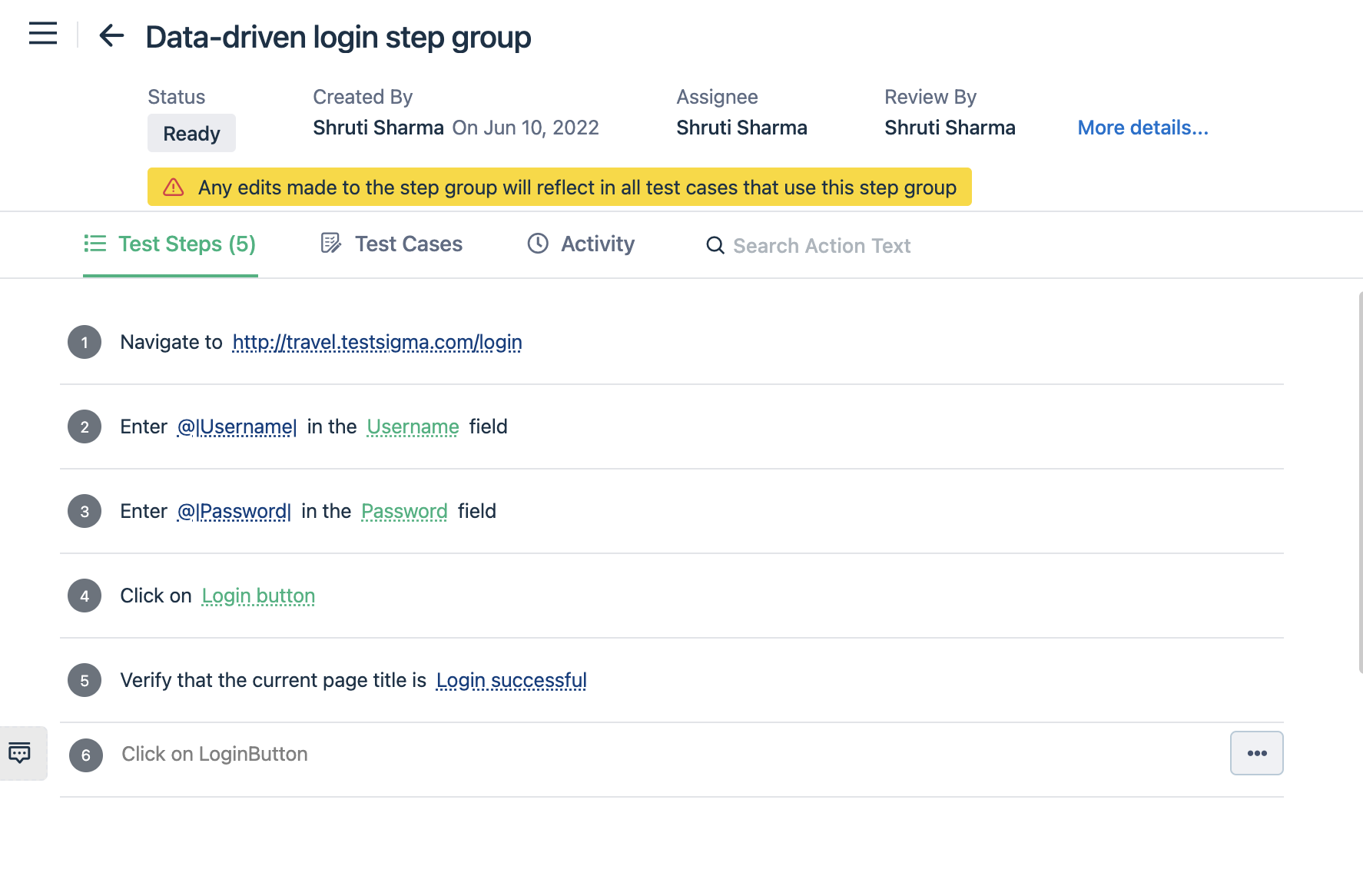
- Now create a data-driven test case that would use a different test data profile of usernames and passwords.
- Inside the test case, create a for loop using a third test data profile of usernames and passwords.
- Inside the for loop, add the step group create in step 2.
- Now try to edit the username and password parameters in the added step group. You will see that you will be able to select the test data profiles being passed to the parent test step too as also shown in the screenshot below:

Additional actions possible on iteration count
- Store: In a step group, when a test data profile is being iterated - an additional action is possible. The iteration count can be stored into a variable for later use. (Iteration count is the current count that is being iterated over the associate test data profile in the step group in Testsigma.) Below is how the syntax for the Store NLP looks like:

- If: The test data set values, from a test data profile being iterated, can be compared within an if condition too. Below screenshot shows the NLP (The NLP can be added as a part of add-on String Compare. You can find the add-ons to use here: https://testsigma.com/addons):
